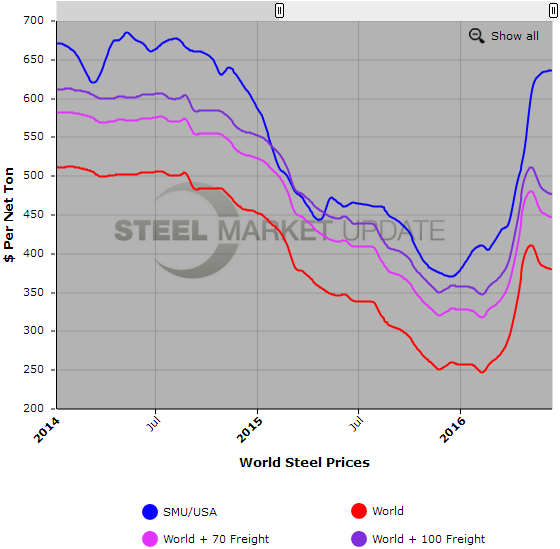International Steel Prices

Analysis of World Export vs. Domestic Hot Rolled Coil Prices
Written by Brett Linton
June 16, 2016
The following calculation is used by Steel Market Update to identify the spread between world hot rolled export prices as determined by SteelBenchmarker and domestic (US) hot rolled prices as published by SMU. Steel Market Update compares the world hot rolled export price to which dollars are added for freight, handling, trader margin, etc. The number generated is then compared to the spot (FOB Mill) domestic hot rolled price using the SMU Hot Rolled Index average for this week, with the result being the spread between domestic and world hot rolled coil prices. This is a “theoretical” calculation as freight costs, trader margin and other costs can fluctuate ultimately influencing the true market spread.
This theoretical price spread analysis is based on our review of world export prices and the hot rolled steel price index produced by SMU earlier this week. As the spread narrows, the competitiveness of imported steel into the United States is reduced. If it widens, then foreign steel becomes more attractive to U.S. flat rolled steel buyers.
![]() SteelBenchmarker World Export Price vs. Domestic
SteelBenchmarker World Export Price vs. Domestic
The world export price for hot rolled bands is $376 per net ton ($414 per metric ton) FOB the port of export according to data released by SteelBenchmarker earlier this week. This is down $11 from the previous release on May 23rd and down $34 per ton over the May 9th update.
SMU uses a minimum of $70 to as much as $100 per ton for freight, handling, and trader margin, which is then added to the export number in order to get the steel to ports in the United States. This puts the theoretical selling price for hot rolled coil exported to the United States as ranging from $446 to $476 per ton CIF USA Port.
The latest Steel Market Update hot rolled price average is $635 per ton for domestic steel, up $5 per ton compared to the last time we did an update on world prices and up $25 per ton over our mid-May price. The theoretical spread between the world HR export price and the SMU HR price is $159 to $189 per ton ($259 prior to import costs), up $16 from our previous analysis and up $59 from mid-May.
The $159 to $189 spread is about $80 to $90 per ton higher than the average spread we have seen over the last few months. Surpassing last month’s previous highs, this is now the highest spread we have seen in our 3+ year history, with the next highest spread being in mid-May 2014 at $84 to $114 per ton ($184 prior to import costs). In January through May of last year, we had more narrow spreads, some negative (meaning theoretically that domestic steel was cheaper than foreign steel). This time last year, it was $13 to $43 ($113 prior to import costs), and in early February 2015, the spread was -$19 to $11 ($81 prior to import costs), the lowest seen since late-May 2013. The widest spread seen between foreign and domestic HRC in 2015 was in mid-August at $42 to $72 per ton ($142 prior to import costs).
Platts European HRC (Ruhr) vs. Domestic
Earlier this week Platts published European HRC prices (Ruhr) at $449 per net ton ($495 per metric ton), and Chinese HRC at $352 per net ton ($388 per metric ton). Calculating in $70 to $100 per ton for freight and trader margins, that puts prices around $519 to $549 per net ton from Europe delivered to the US and $422 to $452 per ton from China (if China were able to ship to the United States which they are not).
The last foreign offers SMU saw were a couple of weeks ago at the $540 (+/-$10) per ton level.
However, all the “theoretical” calculations do not mean anything if there is little to no hot rolled coils being offered into the United States. At this time that is exactly what we are seeing: little to no offers of HRC to the U.S. market. This is due to stronger international business, the U.S. market being protected through the use of dumping suits and the desire to collect higher margins when possible.
Freight is an important part of the final determination on whether to import foreign steel or buy from a domestic mill supplier. Domestic prices are referenced as FOB the producing mill while foreign prices are FOB the Port (Houston, NOLA, Savannah, Los Angeles, Camden, etc.). Inland freight, from either a domestic mill or from the port, can dramatically impact the competitiveness of both domestic and foreign steel.
Below is a graph comparing world HR export prices against the SMU domestic HR average price. We also have included a comparison with freight and traders’ costs added which gives you a better indication of the true price spread. You will need to view the graph on our website to use it’s interactive features, you can do so by clicking here. If you need assistance with either logging in or navigating the website, please contact us at 800-432-3475 or info@SteelMarketUpdate.com.

Brett Linton
Read more from Brett LintonLatest in International Steel Prices

Doubled S232 tariff holds US HR prices below EU
David Schollaert presents this week's analysis of hot-rolled coil prices, foreign vs. domestic.

Higher US CR prices inch closer to EU, Japanese tags
US cold-rolled (CR) coil prices continued to tick higher this week, while offshore markets were mixed.

Stacked S232 keeps US HR prices below EU
US hot-rolled coil prices crept up again this week but still trail imports from Europe.

Doubled S232 lifts EU, Japanese CR prices over US tags
US cold-rolled (CR) coil prices edged up again this week, and most offshore markets moved in the opposite direction. But the diverging price moves stateside vs. abroad did little to impact pricing trends. The bigger impact was from Section 232, which were doubled to 50% as of June 3. The higher tariffs have resulted in […]

CRU: Sheet demand remains weak, tariff changes again alter markets
Subdued demand has continued to weigh on steel sheet prices globally.

